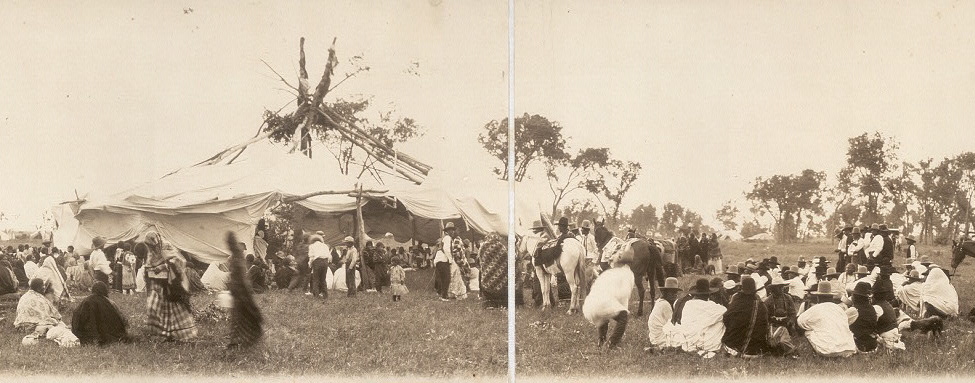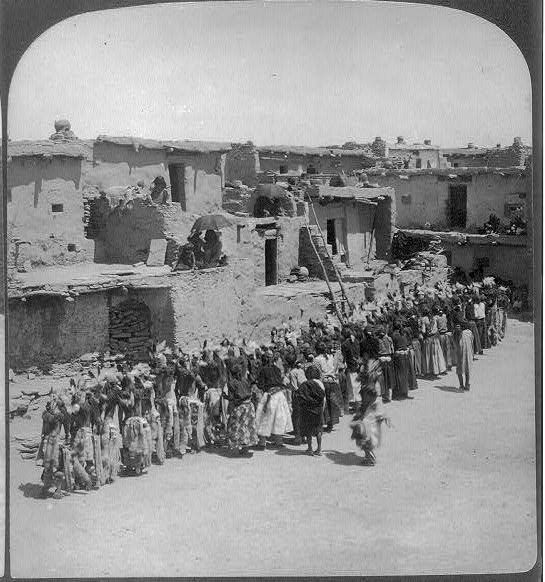Every good quest needs a destination. The best destinations are often hidden or secret. Here, then, are four secret places from four Native American myths. (Taken from American Indian Myths and Legends, collected and edited by Richard Erdoes and Alfonso Ortiz.)
Our first secret place comes from a Slavey story about a terrible winter. Once, there was a winter that seemed to go on forever. The animals were freezing and starving, and they decided to do something about it. No one had seen the bears in a while, so the animals decided the bears must have stolen Warmth. The animals looked high and low for the bears. As it turns out, the bears had settled in the Upper World beyond the sky. The other animals eventually found a hole in the sky (a common feature in many Native myths) and climbed through it. In the upper world, they found a hut on the shore of a great lake, and inside were two bear cubs and the bag in which their mother had stored Warmth. In a daring raid, the animals stole the bag and returned to the earth. But when the animals opened the bag, Warmth escaped and melted all the snow at once. The world would have been destroyed by flood as surely as it would have been by frost, but the animals were saved by a great fish that swallowed up all the water, then turned into a mountain.

The second secret place comes from a Cheyenne myth about the origin of their Sun Dance. Times were hard in the Cheyenne nation, and the people were starving. A young medicine man named Horns Standing Up set out with his love to find a dance that would return abundance to the land. Their journey took them to a tall mountain at the center of a dark forest, and on the edge of an endless lake. The two Cheyennes rolled aside a great rock at the foot of the mountain, and there discovered a tunnel leading into the earth. Inside the mountain was a medicine lodge that resounded with the voice of Maheo the Creator. Maheo taught Horns Standing Up the Sun Dance. And when Horns Standing Up and his love rolled aside the boulder to leave the underground medicine lodge, “buffalo without numbers streamed out of the mountain behind them, and the earth brought forth green shots.”
Our third secret place comes from a Blackfoot story about the origin of horses. The Blackfoot hero Long Arrow went on a quest to find these animals. He traveled and traveled until he was almost dead from hunger, until he came to a great lake surrounded by snowcapped mountains, and fed by frozen waterfalls. Following the directions he’d received, Long Arrow entered the lake, but the water didn’t make him wet, and he could breathe and see. He walked along the bottom until he came to a valley at the center of the lake, where stood a tipi. Painted on its sides were pictures of horses, though Long Arrow did not recognize them, for no one had ever seen a horse before. An old man in the tipi directed Long Arrow to a nearby meadow (still at the bottom of the lake), where the hero encountered horses. He lassoed some and brought them to his tribe. But when he led his people back to the lake to get more, he found the water was no longer passable, and the lake was once more just a lake.

Finally, we have a Hopi myth about the way to the Skeleton House, the place of the dead. A young man was curious what happened to people after they died, and he wanted to see for himself. So his tribe’s medicine man dressed him and painted him the way the dead are prepared, and gave the young man something spiritually potent to eat. After the young man fell asleep, he saw a road leading westward through a plain of enormous cactus and agave plants. The road led the young man to the edge of a steep bluff. A chief resting at the top of the bluff agreed to help the man get down it. He bade the young man put his white kilt upon the ground. The chief tossed the kilt and the young man over the edge, and the young man floated gently to the bottom of the bluff. The young man continued following the road until he came to the Skeleton House, where he saw the dead dwelling as skeletons. The village of the dead was much like a village of the living, except the ladders leading up to the roof entrances of the houses were made of sunflower stems, and they broke under the young man’s weight. The young man stayed a while and learned from the skeletons of his ancestors, and eventually returned to the land of the living, chastened and wiser.
If none of these locations quite suit your needs, but you like the feel of them, consider that they all have the same four elements. Retain the elements, but swap them out for versions that are better-suited to your story and setting, and you should get a secret place that feels the same as these.
– First, each site is remote. The heroes must make a long journey to reach them, and remarkable natural features (endless lakes, plains of enormous cacti) play a role in the journey.
– Second, each site is guarded by some sort of barrier to entry. The first has the hole in the sky. The second has the boulder over the tunnel. The third has the lake’s surface. The fourth has the steep bluff. Overcoming this obstacle is the threshold you cross to enter the other world beyond.
– Third, each location is somehow supernatural: a celestial world, an underground world, an underwater world, or the realm of the dead.
– Fourth – and perhaps most curiously – the supernatural world contains a man-made structure that serves as the center of attention. Even in the Blackfoot story where the tipi at the bottom of the lake wasn’t Long Arrow’s ultimate goal, the storyteller spoke at length (which I pared down) about Long Arrow’s interactions with the man in the tipi, much more than he spoke about the meadow with the horses.






